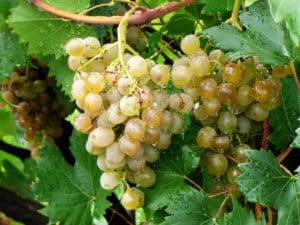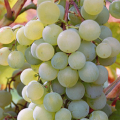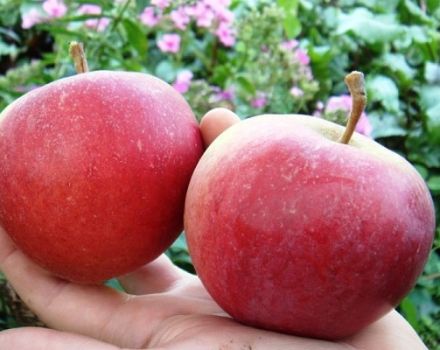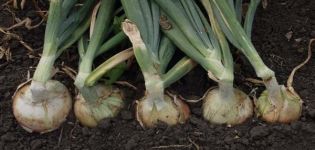Description and characteristics of Viking grapes, pros and cons
Viking is a black table grape, one of the earliest ripening grapes in its category. Has a specific taste, not everyone likes it. Suitable for growing in most regions of Russia, but not everywhere gives a stable harvest. The variety is distinguished by its rapid growth at the beginning of the growing season, so the bushes require long pruning. Viking belongs to medium-sized grapes.
Breeding history
The Viking was bred by the Ukrainian breeder Vitaly Zagorulko. This winegrower has created many varieties with unique flavor characteristics. All of them are suitable for growing in Ukraine and Russia, but mainly in the southern and southwestern regions.
The Viking variety arose as a result of the crossing of Kodryanka and Red Delight (SOZ-1, Zosya). Both species have early ripening periods, differ in large berries and clusters. Viking has the "roots" of Amur grapes, since the Zosia hybrid was bred from European and Amur varieties.
The grapes have not been tested in Russia, but, despite this, they have been actively cultivated in the country for several years.
According to Zagorulko himself, Viking is ideal for regions with a climate close to Zaporozhye (with dry summers, moderately cool, mild winters).
Main characteristics
The grapes ripen in 100-110 days (on average), the harvest can be harvested at the end of summer. The sugar content of the berries is average (15-17%), as is the acidity. Low yield, optimal load on the bush - 22-26 shoots. Often the bushes are underused.
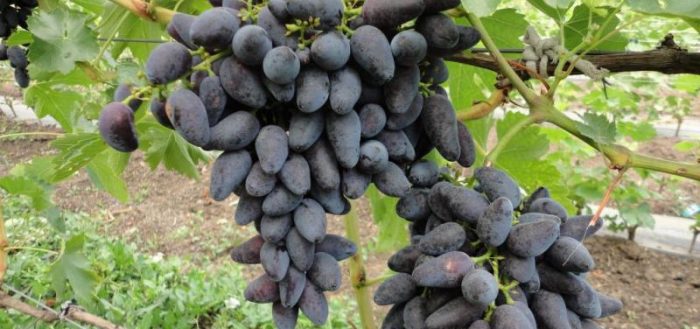
The berries are dense and juicy. The skin is not felt when eaten, but at the same time it protects the fruit from flying insects. Viking is intended primarily for fresh consumption, but is rarely used to produce mixed wines. The variety has a characteristic berry aroma and an unusual taste, which combines notes of cherries, prunes and plums. Fruits quickly accumulate sugar in warm or even hot weather.
Description of appearance:
- clusters of conical shape, by weight above average - from 600 grams to 1 kilogram;
- the berries are large, weighing from 8 to 14 grams, larger than a five-ruble coin, dark blue in size;
- bisexual inflorescences (this promotes rapid pollination);
- leaves are five-lobed;
- shoots are powerful, quickly grow up to 2-3 meters.

Cold tolerates poorly, begins to die at temperatures of -21 ° C and below. Persistent frosts do not survive without good shelter.
Pros and cons of the variety
The variety perfectly tolerates transportation, its berries retain their presentation until the end of September.On the bushes, the fruits do not crack, but dry out to the state of raisins. Despite all this, the species is not commercial, since it does not have a sufficient level of productivity. The main advantages of the variety are its interesting taste, quick ripening and large size.
The main disadvantages of the view:
- instability to temperature extremes;
- low resistance to most diseases;
- capriciousness, due to which not everyone manages to grow grapes.

In conditions of increased heat, the yield of the bushes decreases. The berries become small and taste altered. Typically, such changes occur at 3 years of cultivation.
How to plant correctly?
The hybrid takes root well in chernozem soil, it is best to plant it in the southwestern or southern part of the garden. There should be no strong wind and high groundwater in the landing area. If the land is waterlogged, then drainage is performed or another place for grapes is chosen.
The infertile soil is saturated with trace elements before planting. Special mixtures are used (Novofert), wood ash, humus, prepared since autumn. It is optimal to plant cuttings from mid to late spring, during the daytime, at temperatures from +14 to +22 ° C.

Before planting, you need to check the integrity of the root system of each seedling. It is desirable that it has 3-4 roots 10-15 centimeters long and 2-3 millimeters thick. The plant should be firm, not brittle. After checking the seedling, holes of a cylindrical shape with a depth of 60-80 centimeters are dug. A prerequisite is to maintain a distance of 2.5-3.5 meters between the bushes.
Before planting, humus or other fertilizer can be placed in the hole (layer - 25 centimeters).
A mound of fertile soil forms on the surface, the roots of the seedling are straightened. The plant is placed in the hole at an angle, immediately fixed with a support and poured with warm water (2-2.5 buckets per hole). The soil is loosened.

Growing and care
The main condition is not to overmoisten the soil. Frequent watering has 3 consequences:
- the development of fungal diseases;
- cracking of fruits;
- change in taste, decrease in sugar content.
Therefore, the variety is not suitable for growing in regions with frequent summer rains. On average, it is watered 6-7 times from planting to the end of the harvest. The bushes are not moisturized during flowering and ripening. The grapes are cut in the middle or at the end of autumn, leaving from 3 to 10 fruiting shoots. For the first 3 years, it is better to leave the minimum number of shoots. For the winter, the plant must be covered, a protective layer of sawdust or peat is laid around the roots.
Disease resistance
The variety is resistant to mildew due to its early ripening. It is not resistant to other fungal diseases. It is advisable to treat the plant with fungicides at the beginning of the growing season, and then before and after flowering.
You can use Bordes liquid or other drugs, such as Strobi and Ardent. The plant is resistant to flying insects due to its dense skin.
